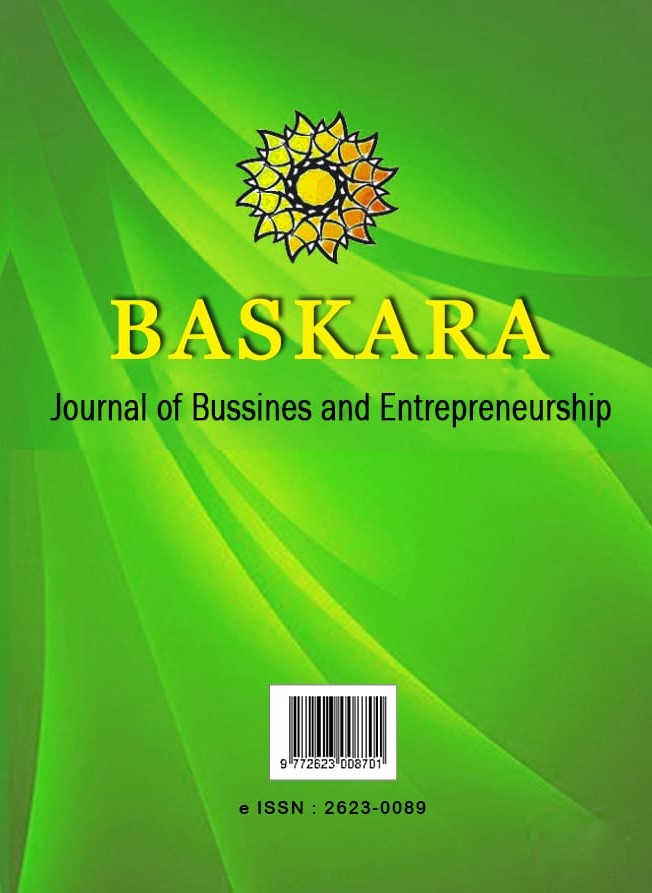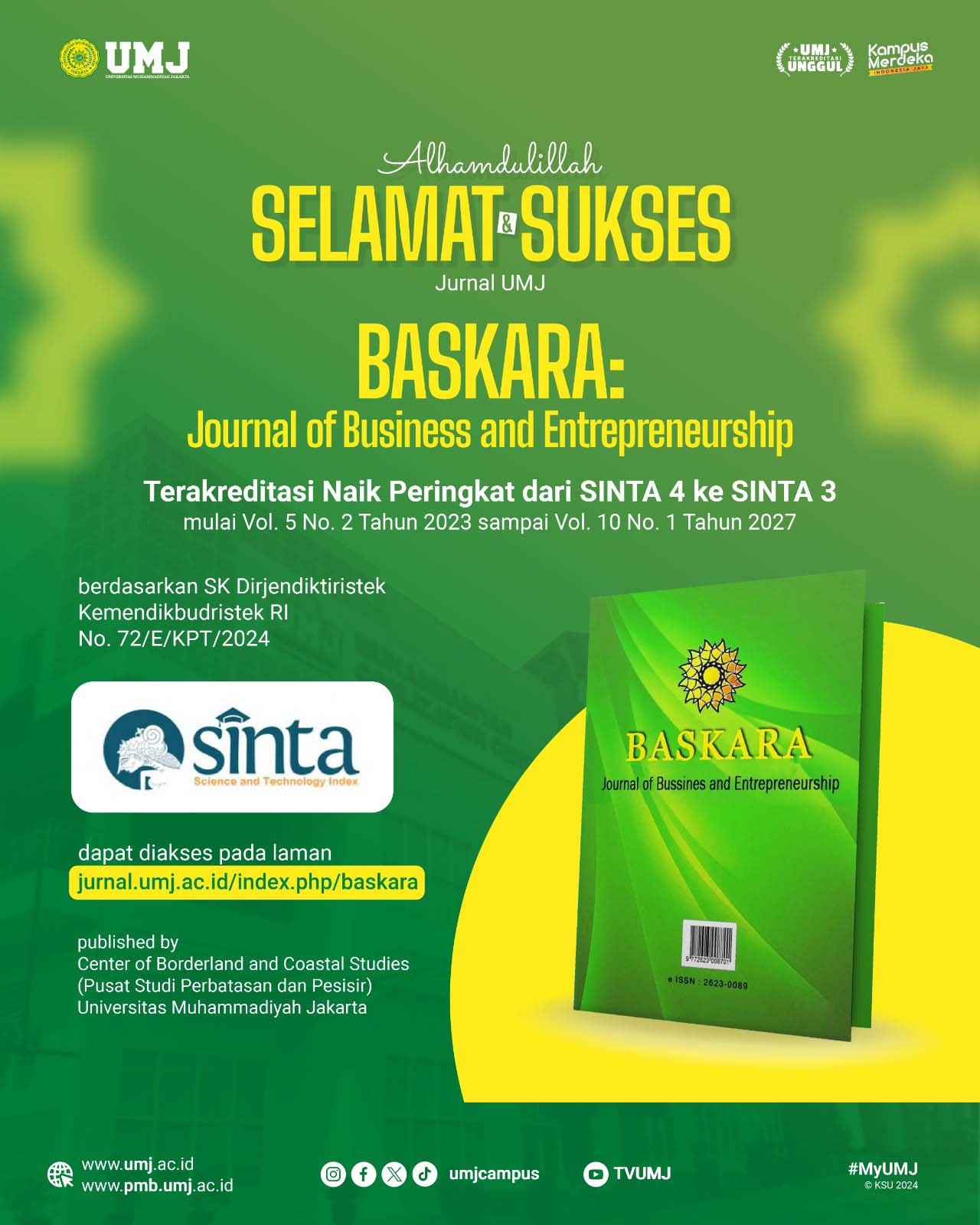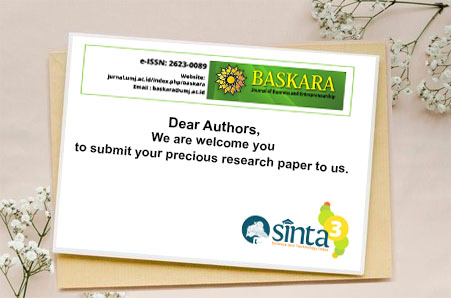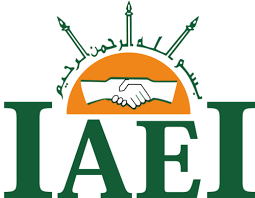Mushroom Cultivation Business Development Strategy with BMC Model During Pandemic Covid 19
DOI:
https://doi.org/10.54268/baskara.v5i2.12409Keywords:
, Business Mode Canvas l, Mushroom Cultivation, Business Development Strategy, Pandemic Covid.Abstract
The COVID-19 pandemic has greatly affected various aspects of people's lives. However, despite all the adversity, several businesses are still able to survive and are expected to continue growing during the crisis. Village-Owned Enterprises (BUMDes) are considered important elements that can play a significant role in awakening and stimulating a sluggish economy in the midst of a pandemic. BUMDes and the mushroom cultivation business unit face several obstacles in marketing, human resources, and increasingly high competition. The type of research used is descriptive with a qualitative approach. This study aims to determine the business development strategy used by the BUMDes Pontang Mushroom Cultivation Business to achieve a new model for business development by using the design of the nine elements of the Business Model Canvas (BMC), which include customer segment, value proposition, channel, customer relationship, revenue stream, key resources, key activities, key partnerships, and cost structure. The results of the SWOT analysis conducted by BMC show that BUMDes could carry out an aggressive strategy. In addition, it also produces a new BMC Design as an improvement alternative choice strategy for customer segments, channels, revenue streams, and customer relationships that can be used for business development, especially during this COVID-19 pandemic.References
Abay, U. (n.d.). Mengandung Protein Tinggi, Permintaan Jamur Meningkat Di Tengah Pandemi Covid-19. In Swadayaonline.com (2021st ed.). Swadayaonline.co. https://www.swadayaonline.com/artikel/8993/Mengandung-Protein-Tinggi-Permintaan-Jamur-Meningkat-Di-Tengah-Pandemi-Covid-19/
Afuah, A., Tucci, C. L., & A Afuah, C. T. (2000). Internet business models and strategies: Text and cases. McGrawHill International Editions Management Organization Series, 2, 358. https://www.researchgate.net/publication/215915163
Carter, M. . & C. C. (2020). The creative business model canvas-Social-Enterprise-Journal. Social Enterprise Journal, 16(2), 1–24. https://www.emerald.com/insight/content/doi/10.1108/SEJ-03-2019-0018/full/html
Chrautwald, J., & Nielsen, C. (2018). Using the Business Model Canvas to Improve Investment Processes. Journal of Research in Marketing & Entrepreneurship. https://www.emerald.com/insight/content/doi/10.1108/JRME-11-2016-0048/full/html
David, F. (2004). Strategic Management, Konsep Manajemen Strategik.
Fauziah, P. (2020). HIRARKI Jurnal Ilmiah Manajemen dan Bisnis STRATEGI PENGEMBANGAN UMKM MENGGUNAKAN BUSINESS MODEL CANVAS (Vol. 2, Issue 2). http://journal.upp.ac.id/index.php/Hirarki
Https://radarjember.jawapos.com/. (n.d.). Pemkab Jember Luncurkan 26 BUMDes untuk Gerakkan Ekonomi Masyarakat (2023rd ed.). https://radarjember.jawapos.com/nasional/31/01/2023/pemkab-jember-luncurkan-26-bumdes-untuk-gerakkan-ekonomi-masyarakat/3/. https://radarjember.jawapos.com/nasional/31/01/2023/pemkab-jember-luncurkan-26-bumdes-untuk-gerakkan-ekonomi-masyarakat/2/
Ibrahim, J., Azhana, A. N., Amanullah, A., Faizah, N., Aziz, A., Hanis, F. N., & Hadi, A. (2015). The Business Model Canvas (BMC) Comparison Among the Three Consulting Companies Comparison of Business Model Canvas (BMC) Among the Three Consulting Companies. International Journal of Computer Science and Information Technology Research, 3, 462–471. www.researchpublish.com
Joyce, A., & Paquin, R. L. (2016). The triple layered business model canvas: A tool to design more sustainable business models. Journal of Cleaner Production, 135, 1474–1486. https://doi.org/10.1016/j.jclepro.2016.06.067
Nurhayati, C. (2018). BUMDes dan kesejahteraan masyarakat desa. Pusat Penelitian, Badan Keahlian, DPR RI, Bidang Kesejahteraan Sosial.
Osterwalder, A., & Pigneur, Y. (2010). Business Model Generation: A Handbook For Visionaries, Game Changers, And Challengers. www.amazon.comsr
Prasetyo, B. B., Baga, L. M., & Yuliati, L. N. (2018). Strategi Pengembangan Bisnis Rhythm of Empowerment Dengan Pendekatan Model Bisnis Kanvas. Jurnal Aplikasi Bisnis Dan Manajemen. https://doi.org/10.17358/jabm.4.2.296
Sorri, K., Seppänen, M., Still, K., & Valkokari, K. (2019). Business Model Innovation with Platform Canvas. In Journal of Business Models (Vol. 7, Issue 2).
Soselisa, J. A., Raharja, S., & Suharjo, D. B. (2017). Analisis Strategi Pengembangan Usaha Supermarket XYZ dengan Pendekatan Model Bisnis Kanvas Analysis of Business Development Strategy of XYZ Supermarket with Business Model Canvas Approach (Vol. 12, Issue 2). http://journal.ipb.ac.id/index.php/jurnalmpi/
Sukmasari, L., Suyaman, D. J., & Hartelina, H. (2021). Canvas Model Business Design (BMC) in Karawang Batik Production Business at Bale Batik Taza Karawang. BASKARA : Journal of Business and Entrepreneurship, 4(1), 49–62. https://doi.org/10.54268/baskara.4.1.49-62
Wijayantini, B., Jember, U. M., & Kerang, G. (2022). DETERMINANTS OF LEADERSHIP AND COMMUNICATION STYLE ON THE PERFORMANCE OF BUMDES MANAGEMENT IN THE. SEGMEN Jurnal Manajemen Dan Bisnis, 18(2), 275–280. http://ejournal.umpwr.ac.id/index.php/segmen/article/view/7835
Downloads
Published
Issue
Section
License
In order for Baskara: Journal of Business and Entrepreneurship to publish and disseminate research articles, we need publishing rights (transfered from author(s) to publisher). This is determined by a publishing agreement between the Author(s) and Baskara Journal. This agreement deals with the transfer or license of the copyright of publishing to Baskara: Journal of Business and Entrepreneurship, while Authors still retain significant rights to use and share their own published articles. Baskara : Journal of Business and Entrepreneurship supports the need for authors to share, disseminate and maximize the impact of their research and these rights, in any databases.
As a journal Author, you have rights for a large range of uses of your article, including use by your employing institute or company. These Author rights can be exercised without the need to obtain specific permission. Authors publishing in Baskara : Journal of Business and Entrepreneurship have wide rights to use their works for teaching and scholarly purposes without needing to seek permission, including:
- use for classroom teaching by Author or Author's institution and presentation at a meeting or conference and distributing copies to attendees;
- use for internal training by author's company;
- distribution to colleagues for their reseearch use;
- use in a subsequent compilation of the author's works;
- inclusion in a thesis or dissertation;
- reuse of portions or extracts from the article in other works (with full acknowledgement of final article);
- preparation of derivative works (other than commercial purposes) (with full acknowledgement of final article);
- voluntary posting on open web sites operated by author or author’s institution for scholarly purposes.
Copyright Transfer Agreement for Publishing (Publishing Right)
The Authors who submit manuscript has to understand that if accepted for publication, mean that all copyright and publishing right of the article shall be assigned/transferred to Baskara: Journal of Business and Entrepreneurship as assigned publisher.
- CC BY-NC: This license allows reusers to distribute, remix, adapt, and build upon the material in any medium or format for noncommercial purposes only, and only so long as attribution is given to the creator.
It includes the following elements:
BY ![]() – Credit must be given to the creator
– Credit must be given to the creator
NC ![]() – Only noncommercial uses of the work are permitted
– Only noncommercial uses of the work are permitted
Baskara (C) Copyright (2022):
BASKARA: Journal of Business and Entrepreneurship by https://jurnal.umj.ac.id/index.php/baskara
is licensed under a Creative Commons Attribution-NonCommercial 4.0 International License








